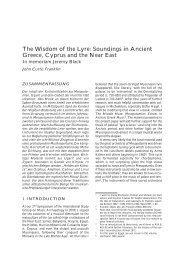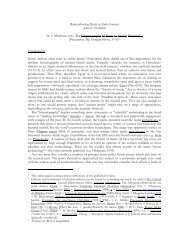KINYRAS AT PYLOS John C. Franklin University of Vermont Kinyras ...
KINYRAS AT PYLOS John C. Franklin University of Vermont Kinyras ...
KINYRAS AT PYLOS John C. Franklin University of Vermont Kinyras ...
You also want an ePaper? Increase the reach of your titles
YUMPU automatically turns print PDFs into web optimized ePapers that Google loves.
‘are themselves said to have ruled the seas once upon a time’. 40 Add to this the tale <strong>of</strong> <strong>Kinyras</strong>’<br />
unfulfilled promise to send Menelaus fifty ships for the expedition against Troy. 41 One should<br />
also note the roles <strong>of</strong> Aphrodite and Astarte as patronesses <strong>of</strong> sailors—one <strong>of</strong> several areas in<br />
which <strong>Kinyras</strong> mirrors the interests <strong>of</strong> his Island Girl, and shows some overlap with the Ugaritic<br />
craftsman-god Kothar-wa-Hasis and his Phoenician descendant Chusor. 42<br />
‘<strong>Kinyras</strong>’ also appears as a typical Cilician fisherman’s name in two entries <strong>of</strong> the Greek<br />
Anthology. 43 These poems, despite their relatively late date, provide a valuable parallel for<br />
‘<strong>Kinyras</strong>’ as a possible personal name at Pylos. There are also occasional epigraphic attestations<br />
from various parts <strong>of</strong> the later Greek world. 44 Yet for the anthologized poet (and no doubt<br />
parents choosing names) <strong>Kinyras</strong>’ is clearly a type, and there are audible echoes <strong>of</strong> ‘the’<br />
<strong>Kinyras</strong>. 45 A weary old man, who in his retirement hangs his humble nets up for the nymphs,<br />
inverts the Cypriote king’s proverbial wealth, and recalls the 160-year lifespan mentioned by<br />
Anacreon in a lost poem. This longevity might also suggest the great antiquity <strong>of</strong> <strong>Kinyras</strong>’ family<br />
aÈto€.<br />
40 Eust. in Dionys. Per. 508–9.18 f. [<strong>of</strong>l KÊprioi] l°gontai d° pote yalattokrat∞sai kairÒn tina ka‹<br />
41 Fifty is the number found in Apollod. Epit. 3.9 and both Eustathius and scholia ad Il. 11.20; it seems<br />
alluded to by Lucian Ver hist. 2.25–6. Cf. Baurain 1980, 294.<br />
42 See e.g. Pl. Com fr. 3 K-A (‘oar-driven goddess’ [if this is the right reading: see ap. crit. in K-A]); cf.<br />
Nonnus Dion. 2.103. Cf. Burkert 1985, 153. <strong>Kinyras</strong> and Kothar/Chusor: Brown 1965.<br />
43 Anth. Pal. 6.25, 26 [Jul. Aegypt.], cf. Brown 1965, 206. Cilicia is an important extension <strong>of</strong> <strong>Kinyras</strong>’ mythology,<br />
as discussed below in connection with the lyre-player seals. A fish appears on one <strong>of</strong> these (no. 113quater in<br />
Boardman/Buchner 1966); perhaps this detail serves to bind the lyre-player to the Syrian Goddess, to whom fish were<br />
sacred (for which see generally Lightfoot 2003, 65–72).<br />
44 Fraser/Matthews 1987–, svv.<br />
45 Compare <strong>Kinyras</strong> as the proverbial Good Man <strong>of</strong> Cilicia in Anth. Pal. 11.236 [Demodocus] (Ovid calls<br />
<strong>Kinyras</strong> ‘pious and mindful <strong>of</strong> propriety’ (pius ille memorque ets / moris), Met. 10.354 f. (Myrrha speaking).






